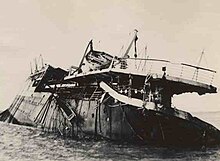Champollion (ship)
|
The Champollion before its renovation with its original three chimneys
|
||||||||||||||||||
|
||||||||||||||||||
|
||||||||||||||||||
|
||||||||||||||||||
|
||||||||||||||||||
The Champollion was a 1925 commissioned passenger ship of the French shipping company Messageries Maritimes , which was used for the transport of passengers and cargo from France to the Middle East . During the Second World War it served as a troop transport . On December 22, 1952, the Champollion ran aground off Beirut due to a navigational error in heavy seas and broke apart. 15 people were killed.
The ship
The 12,213 GRT (7,140 NRT) steamship Champollion was built at the Société Provençale de Constructions Navales shipyard in La Ciotat . The ship was 156.70 meters long, 19.20 meters wide and had three funnels , two masts and two propellers . The Champollion was equipped with two triple expansion steam engines that developed 10,000 hp and allowed a top speed of 16 knots. It was the identical sister ship of by Auguste Mariette named Mariette Pacha , which was built at the same shipyard and from the 8 February 1925 stack ran.
The two ships were built for express transport to Egypt and Lebanon , calling at the ports of Alexandria and Beirut . The Champollion was named after the French Egyptologist Jean-François Champollion . When launching the ship on March 16, 1924 were a great-grandnephew of Champollion, Luynes d'Auteroche, and the President of the shipping company, Georges Philippar , present. The interior of both ships was Art Deco and contained many stylistic elements from ancient Egypt , which became very popular after the discovery of the tomb of Pharaoh Tutankhamun in 1922. The space on board was very luxurious. There were promenade decks , a winter garden , a music room and a kindergarten.
The Champollion's passenger accommodations were designed for 188 travelers in first, 133 in second, 128 in third and 500 in fourth class. The maiden voyage of the Champollion was a cruise from August 3 to 9, 1925. On September 14, 1925, she ran for the first time in Marseille to Alexandria and Beirut. From 1933 Haifa and Port Said were added as ports of call.
In 1933/34 the ship in La Ciotat was temporarily withdrawn from service due to major modifications. The steel hull was lengthened to 171.2 meters and designed in the Maier shape , and the previous machines were replaced by two turbines , which increased the power to 14,600 hp and the speed to 18 knots. The tonnage increased to 13,619 GRT and the load capacity to 5043 tons as a result of the conversions. On August 18, 1934, the ship resumed its regular service. The sister ship Mariette Pacha received no changes.
In 1938 the Champollion was also used for cruises to the Mediterranean and Asia .
Use in World War II
After the outbreak of the Second World War in 1939, the Champollion was drafted for military service and used as a troop transport . In Brest it was originally supposed to be equipped for a trip to Finland , but this was canceled on March 13, 1940. Between July and September 1941 she made two trips to bring troops back to Beirut. On December 1, 1942, she ran from Algiers to Casablanca , from where she continued to Dakar . When the majority of officers refused to leave Dakar, the captain attempted suicide. But he could be saved.
Back in Casablanca, the Champollion was subordinated to the British War Shipping Administration and handed over to the management of the British shipping company P&O . On March 14, 1944, it was damaged in a German air raid in Naples . Exactly one month later, on April 14, 1944, it was again affected in Bombay when the British freighter Fort Stikine exploded in its immediate vicinity. In 1945 she was used to repatriate British troops. In 1946 it was returned to the Messageries Maritimes, but is still used for troop trips to Indochina , Madagascar and North Africa .
Downfall
Between September 1950 and March 1951, the Champollion was completely overhauled in order to be able to be used again as a passenger ship on the usual route Marseille-Alexandria-Beirut after years of military service. The previous three chimneys were removed and replaced by a single one, and the passenger accommodation was rebuilt so that 207 people could be accommodated in first class, 114 in tourist class and 150 in third class. On March 16, 1951, she left for her first post-war voyage to Beirut.
On Monday, December 1, 1952 at 12.30 p.m., the Champollion set sail with 120 crew members and 111 passengers on board under the command of Captain Henri Bourde in Marseille for her next voyage to Beirut. Three weeks later, on December 22, 1952, the ship reached Lebanese waters in stormy seas. The captain was sleeping at the time.
With the Al Manara lighthouse out of order, the Champollion headed for another light that turned out to be the airport beacon , 15 kilometers south of the port of Beirut. By the time the crew noticed the mistake, it was already too late. The ship ran aground off the coast of the suburb of Khalde, only about 600 meters from the beach. The stranded ship broke at wind force 8 to 9 and at a blow page 20 to 30 degrees to the starboard apart. 15 people drowned trying to swim ashore. Several ships and also the Lebanese army participated in the rescue attempts. The wreck was sold to the Lebanese National Engineering and Trading Company and scrapped.

